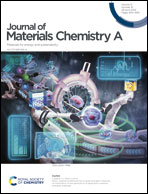Enhancing the thermoelectric performance of donor–acceptor conjugated polymers through dopant miscibility: a comparative study of fluorinated substituents and side-chain lengths†
Abstract
Conjugated polymers present a compelling option for thermoelectric applications due to their low working temperatures, good compatibility with solution-processing techniques, and high potential for scalability. However, the inherently low electrical conductivities of the pristine conjugated polymers necessitate improvements via doping methods. Doping effectively enhances the electrical conductivity by increasing the charge concentration and mobility within the conjugated polymer matrix. Hence, the present study investigates the compatibility between a ferric chloride (FeCl3) dopant and four distinct conjugated polymers and evaluates the effects of the dopant/polymer combination on the thermoelectric properties of the material. First, the influence of backbone engineering is investigated via a comparison between 4-(3′,4′-difluoro-3,3′′-bis(2-hexyldecyl)-5′′-methyl-[2,2′:5′,2′′-terthiophen]-5-yl)-7-methylbenzo[c][1,2,5]thiadiazole (PC16BTF) and 4-(3,3′′-bis(2-hexyldecyl)-5′′-methyl-[2,2′:5′,2′′-terthiophen]-5-yl)-7-methylbenzo[c][1,2,5]thiadiazole (PC16BTH). These polymers differ in that PC16BTF incorporates two fluorine-atom substituents on the thiophene ring, while PC16BTH contains hydrogen atoms in these positions. Then, the effects of various side-chain lengths are investigated by comparing the abovementioned PC16BTH with both 4-(3,3′′-bis(2-butyloctyl)-5′′-methyl-[2,2′:5′,2′′-terthiophen]-5-yl)-7-methylbenzo[c][1,2,5]thiadiazole (PC12BTH) and 4-methyl-7-(5′′-methyl-3,3′′-bis(2-octyldodecyl)-[2,2′:5′,2′′-terthiophen]-5-yl)benzo[c][1,2,5]thiadiazole (PC20BTH). The FeCl3 dopant was selected for its suitable size and charge transfer capability, which significantly influence the thermoelectric performance of each conjugated polymer. As a result, PC16BTH exhibits the highest power factor (PF) of 22.4 μW m−1 K−2 due to its moderate side-chain length and relatively high doping efficiency. Thus, the present study provides valuable insights into suitable strategies for improving the compatibility between dopants and polymers, thereby offering a promising avenue for further enhancing the thermoelectric performance of doped conjugated polymers.



 Please wait while we load your content...
Please wait while we load your content...